Samsung QE65QN95C Review
Samsung’s first Mini LED TV of 2023 is a spectacular one
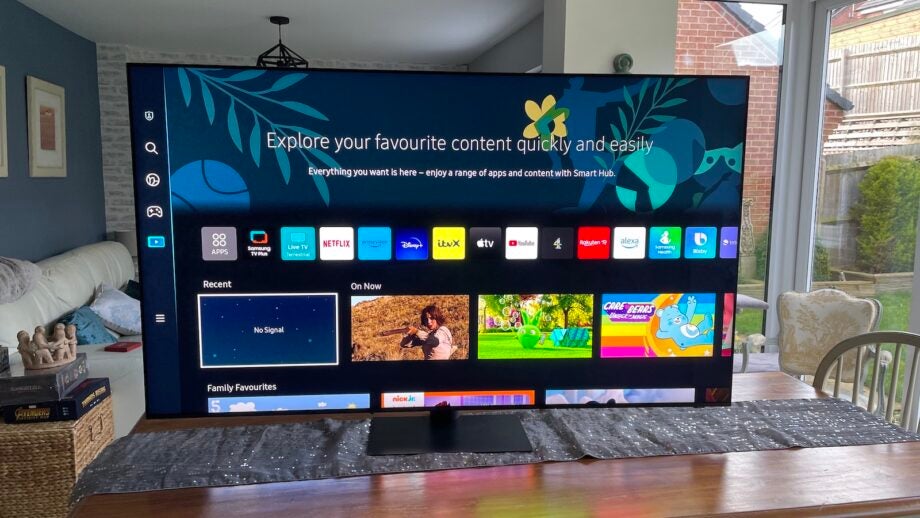

Verdict
Samsung’s first Mini LED TV of 2023 takes on the latest OLED generation with a massive increase in dimming zones – and the results are nothing short of spectacular.
Pros
- Stunningly bright, colourful pictures
- Groundbreaking LCD black levels
- Excellent gaming support and connectivity
Cons
- No Dolby Vision support
- A few backlight niggles
Key Features
- 65-inch 4K screenThe screen contains a pixel count of 3840 x 2160
- Mini LED lighting systemThe screen is illuminated by LEDs only one fortieth the size of regular TV LEDs
- OTS+ sound systemSpeaker ranged around the screen help to make sound effects appear to be coming from the correct part of the screen
- Tizen Smart systemSecond gen of the new full-screen interface Samsung introduced in 2022
- 1344 local dimming zonesThe number of independently controlled lighting zones the TV is able to use when illuminating its pictures
Introduction
While much of the chatter ahead of 2023’s TVs hitting shop shelves has been about various types of OLED technology.
Samsung’s new QE65QN95C is out to prove that Mini LED technology not only still has a place at the high end TV table, but can still do a few things that even the most advanced of the latest OLEDs cannot.
Availability
- UKRRP: £3699
- USARRP: $3299.99
- EuropeRRP: €3699
- Canadaunavailable
- Australiaunavailable
The Samsung QE65QN95C (QN65QN95C in the US) has launched with a UK price of £3,699 and a US price of $3,299.99. The set doesn’t appear to be available in Australia at the time of writing, with only the step down QN90C and QN85C models currently listed.
Its UK and US prices clearly establish the QN95C as a premium TV – in fact, they’re £100 and $100 higher than the prices of Samsung’s eagerly anticipated new 65-inch S95C Quantum Dot OLED TVs. Which clearly tells you something about how much store Samsung puts in the QE65QN95C’s Mini LED-based capabilities.
The Samsung QE65QN95C has just become available for pre-order at the time this review was written in both the US and the UK, with 85-, 75- and 55-inch options available alongside the 65-inch model under consideration here.
Design
- Monolith-style profile
- Solar-powered remote control
- No One Connect box this year
The Samsung QE65QN95C successfully continues the tradition for monolithic design that’s marked Korean brand’s premium Neo QLED Mini LED models out for the past couple of TV generations. The rear panel is pretty much as flat as the front, creating an attractively slender, futuristic profile well suited to wall-mounting.
The rear isn’t as slim as OLED screens tend to be, at least at their edges, but the so-called Neo Slim sculpting is certainly skinny enough to remind you that this TV is lit by mini LEDs rather than the 40 times bigger lights found in Samsung’s regular LED TVs. In fact, the design’s all-round slimness by LED standards finds Samsung classifying it as having an Infinity One Zero-bezel design of the sort that you previously only got with Samsung’s 8K TVs.
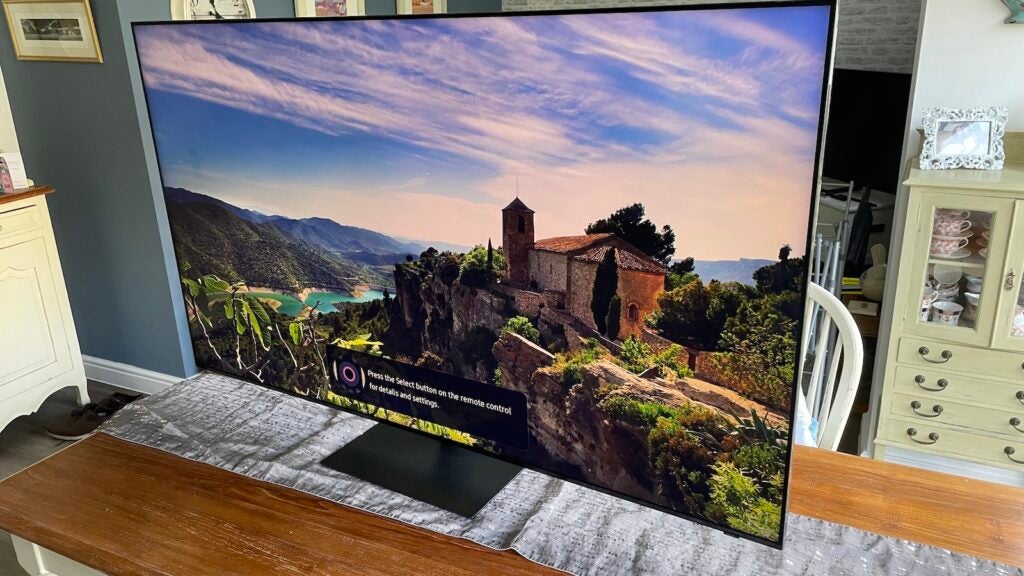
The dark finish of the ultra-thin frame around the screen perhaps lacks a little of the glamour and glimmer of previous Samsung Mini LED flagships, but the 65QN95C is still a good looking thing overall.
If you’re not wall hanging it, the Samsung QE65QN95C can be mounted on a nicely made central foot plate that fits comfortably onto even very narrow support furniture.
Perhaps the biggest change from previous flagship 4K mini LED TVs is that the QN95C no longer houses its connections on an external One Connect box. A move Samsung has presumably made to make the 65QN95C a bit less expensive.
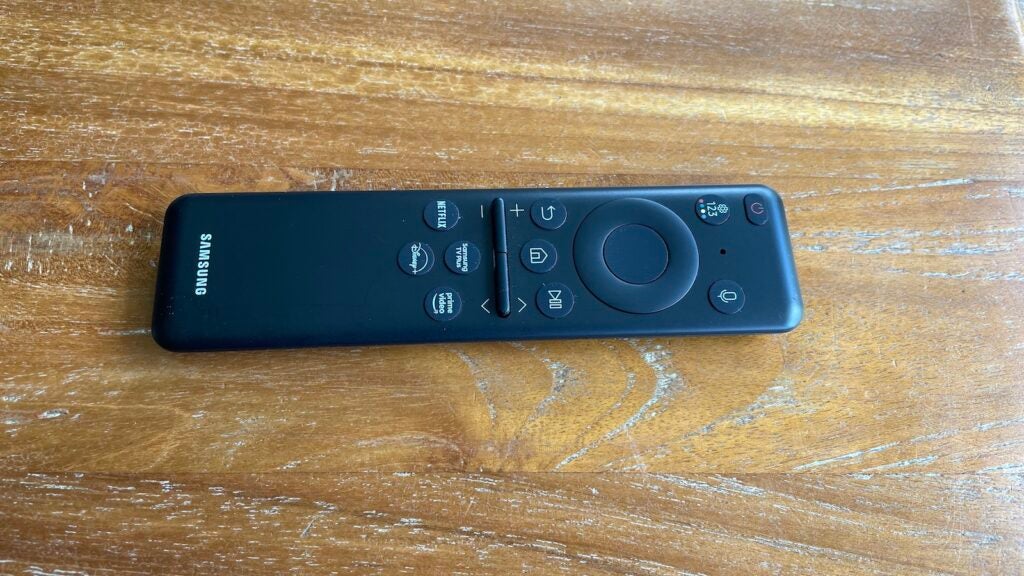
As with most Samsung TVs for years now, the 65QN95C ships with two remote controls: a standard button filled one, and a stripped back, much smaller ‘smart’ one. The standard one looks basic and feels plasticky, but is actually very easy to use. The smart one, though, will likely be the main day to day handset for most households. So it’s a shame that it feels rather plasticky and small for the main handset for a TV as high-end as the Samsung QE65QN95C.
One great thing about the smart remote, though, is that it is powered by either a solar panel built into its back edge or, remarkably, the Wi-Fi signals being beamed around your house by your broadband router. Never having to buy a battery for this remote will help recoup at least a few quid of your outlay on the TV over the years.
Features
- 4K resolution
- Mini LED lighting with 1344 dimming zones
- 4K 120Hz and VRR gaming support on all HDMI inputs
While Samsung’s 2022 Mini LEDs chiefly relied on improved processing and a shape adaptive light control enhancement to distinguish them from their predecessors, for 2023 Samsung has gone much more radical by fitting the 65QN95C with a whopping 1344 local dimming zones versus 720 on the 65QN95B.
Together with Samsung’s already well-established prowess when it comes to local dimming and power management, this huge dimming zone increase has the potential to take picture quality to a whole new level.
Samsung’s latest Neural Quantum processor drives both the QE65QN95C’s backlight engine and its myriad other picture enhancement processing systems, and this too has been improved over its predecessor. It now draws on the combined accumulated knowledge of a massive 20 different neural networks, and introduces a new Real Depth Enhancer Pro feature that combines object detection and manipulation with the TV’s extra dimming controls to create a more three-dimensional, lifelike depth to the picture.
The improvements to the Quantum processor also apparently yield improved upscaling of HD and SD sources, and Samsung has finally also decided the time is right to bring back HDR Remastering after abandoning it a few years ago. Though at the time of writing the full operation of this promised feature appeared to be still awaiting firmware activation.
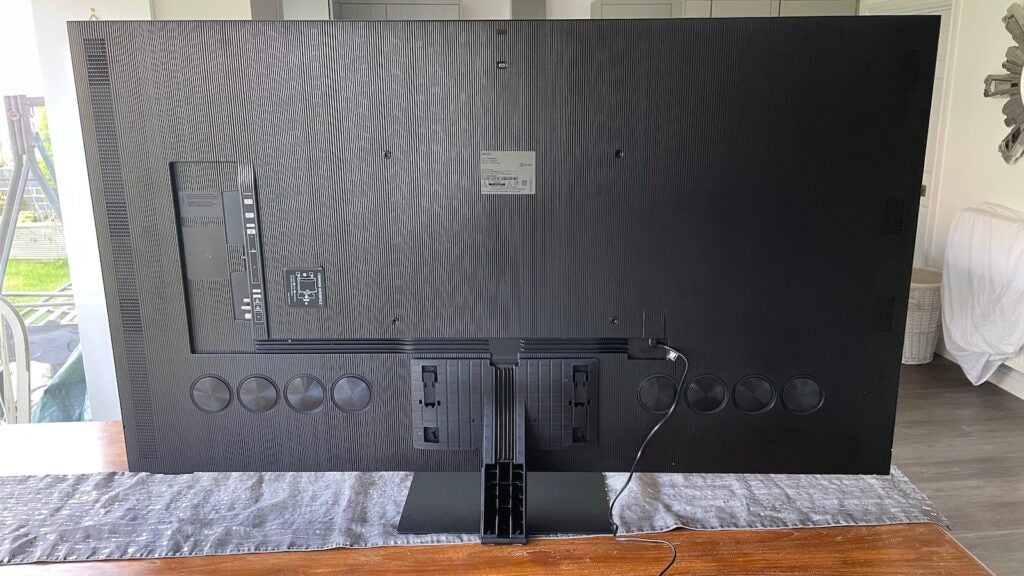
Perhaps the most unexpected new feature of the Samsung QE65QN95C is that it ships with a slim-fit camera in the box. This can easily be attached to the TV as and when you want to enable video calls, but it also introduces the potential for gesture controls as well as opening up the option in some territories to monitor your form while following work out videos, or even checking and managing vital signs such as heart rate, oxygen levels and stress. All without the need for any further accessories.
The QE65QN95C’s connections are dominated by four HDMI ports all of which, I’m pleased to say, can support 48Gbps. That means they can all handle 4K at 120Hz gaming signals (refresh rates of up to 144Hz are possible), as well as variable refresh rates including the AMD FreeSync Premium Pro and (although it’s not formally stated) Nvidia G-Sync.
Also there to keep gamers happy is auto low latency mode switching, and the return of the Game Bar Samsung introduced last year. Accessed by holding down the play button on the smart remote, this menu gives you key information about the gaming signal the TV is receiving, and provides quick access to specific gaming related features.
These include being able to choose your preferred balanced between input lag and picture quality (with the fastest lag figure being an outstanding 9.8ms with 1080p/60Hz feeds, which rises to 16.6ms in the ‘Faster’ mode and 26ms in ‘Fast’ mode). You can also adjust the brightness of just dark parts of the picture (to make hidden enemies easier to see), and the abilities to put a virtual aim point in the centre of the screen and magnify and share a game’s mini-map.
The QE65QN95C’s audio specs of 70W of power fed into a 4.2.2 channel speaker configuration are impressive on paper, and deliver more power than you get with the step-down QN90C range. Dolby Atmos decoding is built-in too, and this should be bolstered nicely by the 65QN95C’s premium version of Samsung’s Object Tracking Sound technology.
This uses speakers ranged around the TV’s frame to deliver a larger, more accurately detailed sound stage that manages to make effects sound as if they’re coming from the correct part of the screen.
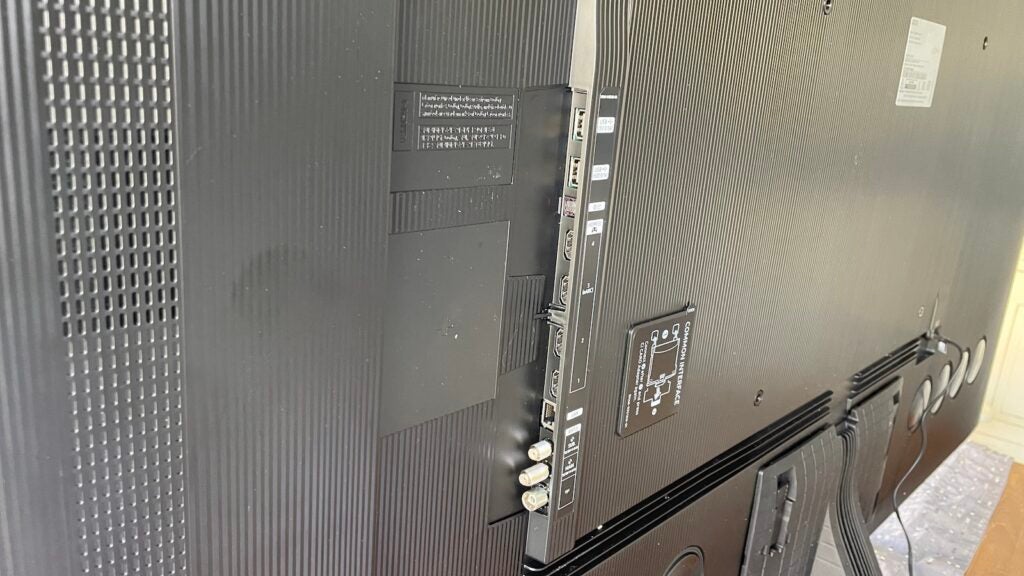
The QE65QN95C also offers an AI-enhanced version of Samsung’s Q Symphony feature this year, too, enabling the speakers in the TV to combine with those in a Samsung soundbar more effectively to create a larger, more detailed soundstage.
Fans of accurate pictures will be pleased to hear that as well as relatively ‘true’ Movie and, especially, Filmmaker mode, the Samsung QE65QN95C supports the fullest version of Samsung’s Smart Calibration system, where you can perform a near professional-grade calibration of your TV using just your smartphone.
The QE65QN95C’s Tizen-based smart interface initially looks the same as the newly designed one introduced last year – and maintains some of that reboot’s unhelpful design and navigation choices. Closer examination reveals that Samsung has put more useful content shelves on the home page this time round, as well as expanding the channels offered on its free and curated live-streaming TV Plus service and adding more content and options to its Gaming Hub of streamed and connected game sources.
Picture Quality
- Phenomenal brightness
- Remarkable, OLED-like black levels
- Bold colours and extreme sharpness
In most ways the QE65QN95C’s pictures improve substantially on the already stellar efforts of its predecessors, with the substantial increase in dimming zones proving particularly helpful in taking things to a new level.
The extra backlight precision actually impacts pretty much every aspect of the QE65QN95C’s pictures, but is especially noticeable when it comes to the presentation of mid-dark scenes. With this substantial increase in light control means there’s much less need to compromise such shots with either watered-down black levels or reduced brightness in a bid to avoid the sort of backlight blooming around bright objects that Samsung sees – with some justification – as being picture quality enemy number one.
There’s even less chance of you catching a glimpse of any blooming where the occasional bright object punctuates an otherwise very dark shot either.
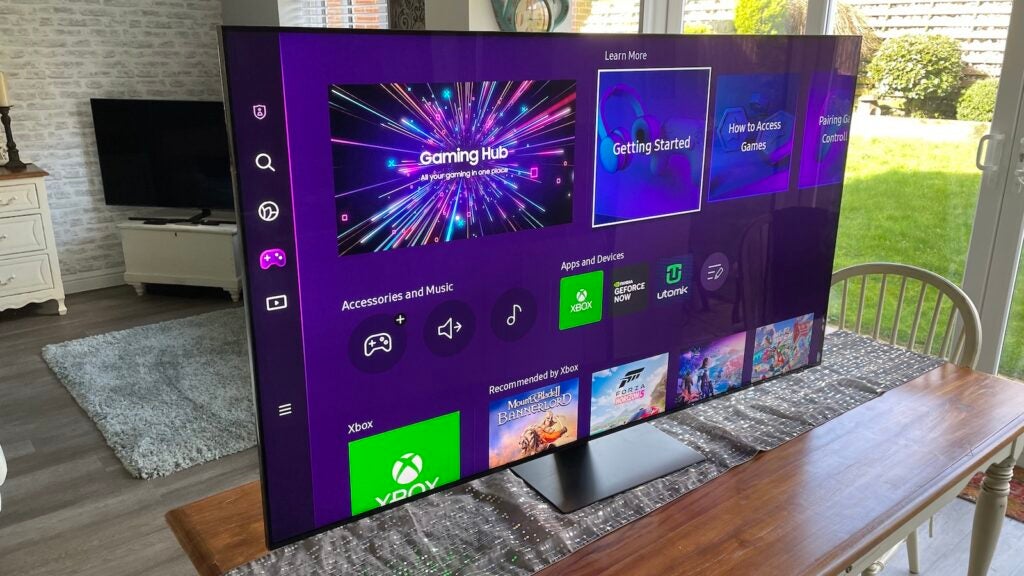
In fact, unless you watch the Samsung QE65QN95C from a fairly steep angle above or below the screen, you’ll struggle to spot any backlight blooming around even the most stark and extreme contrast areas. There’s simply no other LCD TV out there that uses local dimming that limits backlight blooming as well as the QE65QN95C. Even viewing the TV from down its left or right sides doesn’t cause blooming to become significantly obvious this year.
Making this dimming-zone based achievement all the sweeter is the fact that the Samsung QE65QN95C can deliver a sensational combination of inky black levels and extreme brightness. Fade to blacks and the darkest corners of the darkest pictures achieve pretty much perfect blackness in most presets, with no overlying greyness or infusion of blue or green sub-tones.
While at the other end of the spectrum, I measured a whopping 2240 nits of brightness on a 10% white HDR window in the TV’s Standard mode, and this only drops to a still massive 1995 and 1990 nits when you switch to the less punchy/more accurate Movie and Filmmaker modes respectively.
The QE65QN95C’s more refined light engine makes it almost ridiculously good, too, at finding an extra gear of intensity for stand-out bright picture elements even when they appear within an already super-bright full-screen image.
Even the new MLA OLEDs and second-gen QD OLEDs won’t get close to these sorts of numbers – and the Samsung QE65QN95C stretches its brightness advantage over those OLED rivals even further with a huge full-screen brightness of more than 800 nits.
Of course, brightness isn’t everything. Even in the HDR world, with its expanded brightness range, the dark end of the light spectrum is at least as important as the bright stuff. But the QE65QN95C’s brightness certainly gives it a resplendent canvas to paint its pictures on.
This QE65QN95C’s intense brightness plays into a seriously voluminous colour palette that sustains rich saturations even in the very brightest picture areas. There’s precious little sign of clipping in these ultra-bright highlights, either, meaning they retain good detailing and tonal subtlety rather than flaring out.
The much finer light controls ushered in by 65QN95C’s increased dimming zone count also help the TV produce more consistently rich and balanced colours across the image, especially in mid-bright shots.
While it’s the vibrancy and consistency of colours that you notice first, at least in the default Standard and fun but ultimately over-cooked Dynamic picture presets, you soon also spot how subtle they are. There’s precious little sign of colour banding or striping, while even the slightest skin-tone gradations are delivered beautifully, avoiding the patchy or plasticky look lesser TVs can display.
This colour finesse plays into a phenomenal sense of sharpness and detail with native 4K sources too (provided you’ve turned the TV’s noise reduction system off). Unlike Samsung TVs of a few years ago, moreover, there’s nothing forced or noisy about this spectacular sharpness, even if you stick with the default out of the box sharpness settings.
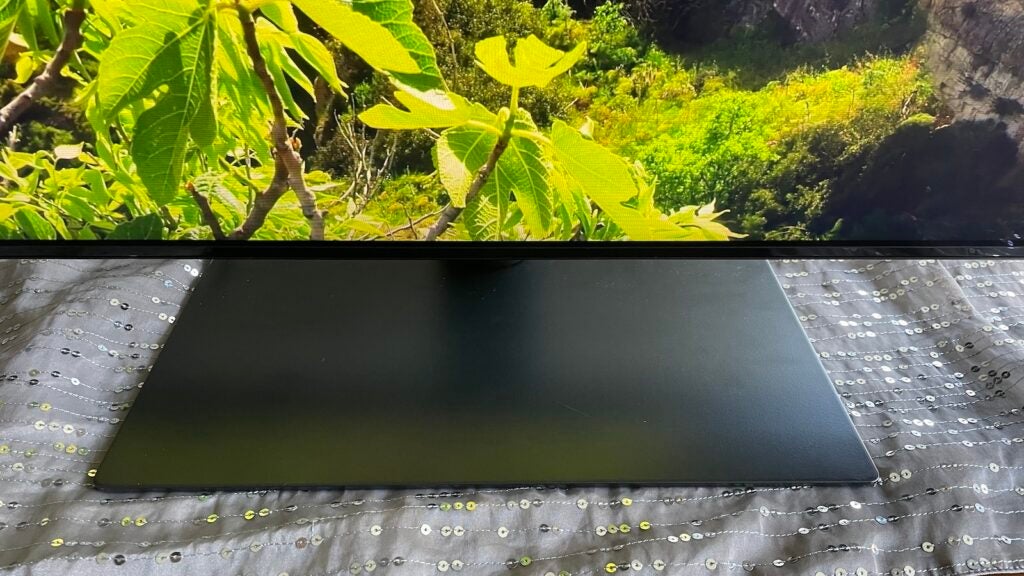
Upscaling of HD and even SD sources is expertly done, with masses of detail and image density added without noise being exaggerated or significant colour shifting.
With a little careful manipulation of the TV’s Picture Clarity settings (personally I like the Custom Mode with judder and blur reduction set to around level three), the Samsung QE65QN95C can handle 24p movie motion quite effectively too, while the set’s expert handling of 120Hz gaming content and variable refresh rates contributes to one of the most spectacular, responsive and engaging gaming experiences I’ve had on any TV.
Probably inevitably, the remarkable range of the QE65QN95C’s accomplishments doesn’t come without a few performance strings attached. The most distracting of which is the extent of the backlight’s adjustments when a scene switches sharply between very dark and very bright shots in the out of the box Standard preset.
The amount that the image dims after the cut to a very dark shot happens, and the slight delay in this dimming happening, together with a similar delayed re-infusion of brightness when a scene cuts sharply back to a much brighter shot, can be really very noticeable.
To be fair, content that causes this problem is pretty rare, and you can also fix the issue by turning off the TV’s Contrast Enhancer feature. This does rob the image of some of the punch that will make the Standard preset so endearing, I think, to many 65QN95C buyers.
Even with all its extra dimming zones, meanwhile, the 65QN95C still sometimes dims down small bright objects that appear against dark backdrops quite heavily. This happens less frequently than it did with the QE65QN95B, but Samsung’s drive to eliminate backlight blooming means the object dimming issue has certainly not disappeared.
The Standard and, more surprisingly, Filmmaker modes can suffer with some shadow detail crushing in their default states too, with the Filmmaker mode being also slightly more prone with really extremely dark shots to suffering with a mixture of ‘black holes’ and mild blooms than the other presets.
The Movie mode, on the other hand, arguably brings a little too much shadow detail out, leaving all three presets in need of some gentle manual intervention – at least if you’re in the habit of watching ‘difficult’ films full of TV picture quality torture tests.
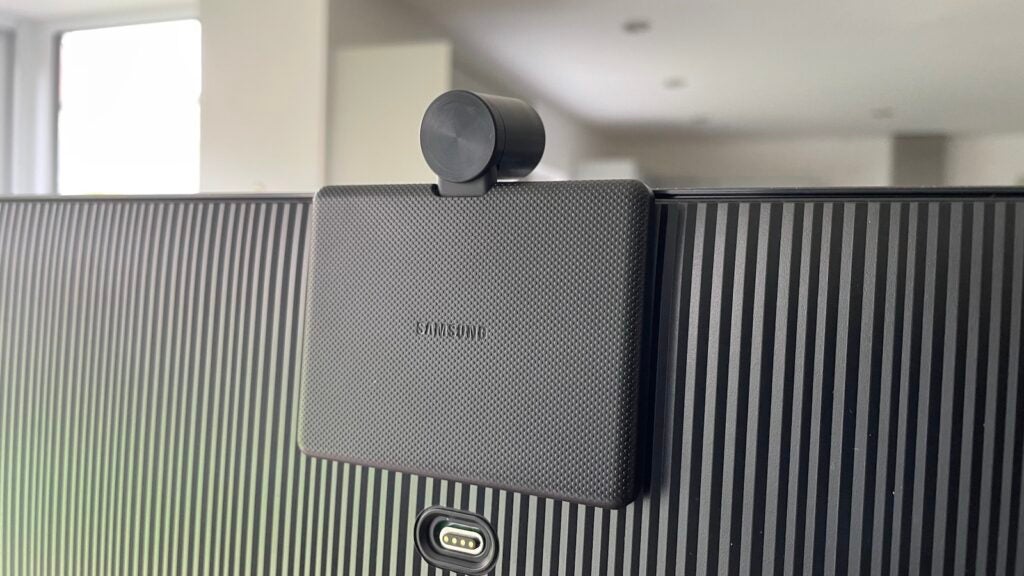
The 65QN95C’s default Picture Clarity settings are a mess for the Standard preset, causing way too much soap opera effect and unwanted processing detritus (I’ve already discussed the fix for this), while 24p judder seems a touch excessive if you turn motion processing off altogether. Perhaps this is made more noticeable, in part, by the TV’s extreme brightness.
While SDR HD footage can look spectacularly bright in the Standard preset, this brightness can cause the occasional shot to look a little noisy unless you calm things down a bit in the picture settings. Finally – though this is more of a comment on an inevitable situation rather than a criticism – if you spend much time watching the Standard preset, you may find the much duller, less dramatic look of the Movie and especially Filmmaker Modes quite hard to adapt to.
Of course, these presets are only doing what they’re supposed to do in adhering to mastering values, so it’s actually a positive rather than a negative to see Samsung not trying to muck around too much with these settings this year.
When push comes to shove, though, there’s nothing wrong with the QE65QN95C’s pictures that can’t be greatly improved by a little judicious tweaking, or is serious enough to stop the TV from being ultimately defined by the many things it gets spectacularly right.
Sound Quality
- 4.2.2-channel sound
- Dolby Atmos decoding
- OTS effect works very well
The QE65QN95C’s audio is a welcome step up from that of its predecessor, enjoying more power, more clarity and more scale, while simultaneously being much less prone to speaker crackling or cabinet buzz.
The latest Object Tracking Sound system manages to position effects in a busy mix in the right part of the image so accurately that it’s hard to believe there isn’t a bank of speakers sat right behind the screen. It helps the OTS effect, too, that the general audio delivery is cleaner and slightly better projected, driven by power that seems able to emerge with more force from a row of eight drivers along the TV’s rear and the other detail speakers ranged around the TV’s frame.
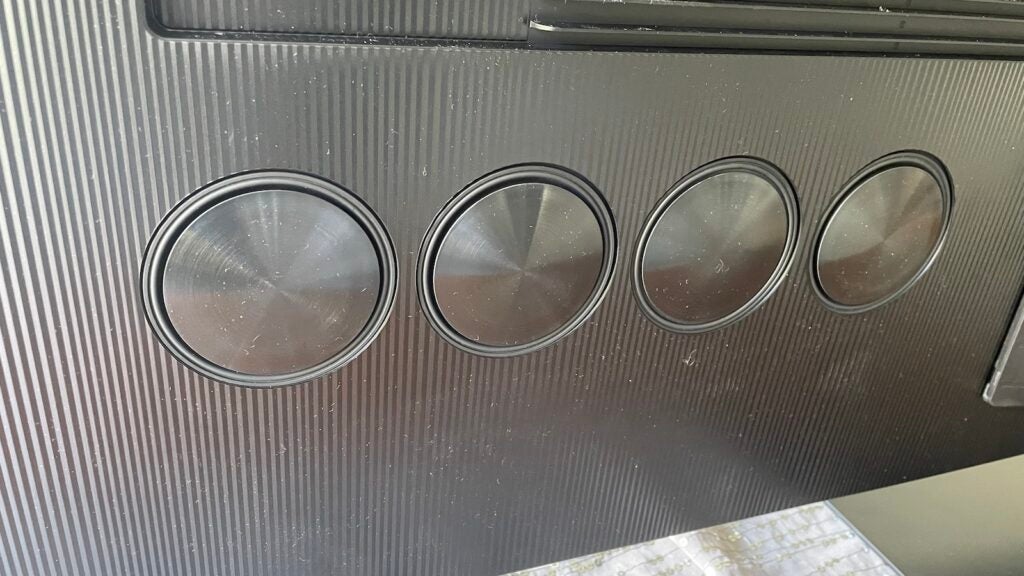
The speakers are sensitive enough and the power handling is astute enough to bring out even the subtlest details in a mix too, and while bass still isn’t as deep or forceful as I’d ideally like, the overall cleaner presentation gives dynamic-sounding scenes a more rounded and immersive feel.
The 65QN95C’s audio strengths help it get more value out of Dolby Atmos mixes than most built-in TV audio systems too. At the same time, powerful Atmos moments do reveal that the TV’s sound only really projects sideways or backwards rather than pushing forward into your room, and that it doesn’t have quite enough raw power to meet the full scale of the most extreme soundtrack moments.
Latest deals
Should you buy it?
Dazzling bright and colourful pictures meet class-leading black levels: If you want enough punch to turn HDR up to 11 and pictures that still excite in a bright room, the 65QN95C’s mini LED engine is uniquely effective.
Some settings need care: Despite the 65QN95C sporting a mighty processing brain, some parts of its default picture settings need to be tweaked to give you the best results.
Final Thoughts
The Samsung QE65QN95C isn’t exactly cheap and looks set to find itself up against some fierce competition this year from a new generation of OLED technology.
Happily, though, almost doubling the number of dimming zones it uses to light its mini LEDs compared with its predecessor has a profound effect on everything from black levels to contrast and colour, ensuring that the 65QN95C still enough unique strengths to stand tall against the latest OLED onslaught.
How we test
We test every television we review thoroughly over an extended period of time. We use industry standard tests to compare features properly. We’ll always tell you what we find. We never, ever, accept money to review a product.
Find out more about how we test in our ethics policy.
Test with real world use
Benchmarked with tests
Tested for a month
FAQs
This is the name Samsung gives to its TVs that combine Quantum Dot colours with mini LED lighting.
This describes a system where different areas of a TV’s backlighting can output different levels of light at any given moment, to increase contrast.
This stands for Object Tracking Sound, a Samsung audio system that combines speakers ranged around a TV’s bodywork with clever audio processing to make sound effects seem to be coming from the correct place on the screen.
Full specs
Sustainability
Trusted Reviews’ holds the fact that global warming is not a myth as a core value and will continuously endeavour to help protect our planet from harm in its business practices.
As part of this mission, whenever we review a product we send the company a series of questions to help us gauge and make transparent the impact the device has on the environment.
We currently haven’t received answers to the questions on this product, but will update this page the moment we do. You can see a detailed breakdown of the questions we ask and why in our sustainability info page.







